
Sultan Khan |
The e-mail address is chessnotes@chesshistory.com. Correspondents are asked to include their name and full postal address and, when providing information, to quote exact book and magazine sources. The word ‘chess’ needs to appear in the subject-line or in the message itself.
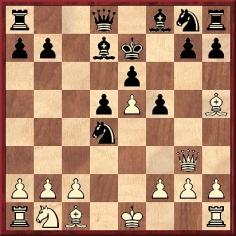
Black has just played 9...Ke7, and White replied 10 Qa3 mate, which was described as an ‘airplane checkmate’ on page 292 of The Fireside Book of Chess by Irving Chernev and Fred Reinfeld (New York, 1949). Were they the inventors of that term, and how exactly might it be defined?
The position arose in a game between M. Karff and O. Lugatsch, Berlin, 1937, published on page 270 of the December 1937 Chess Review:
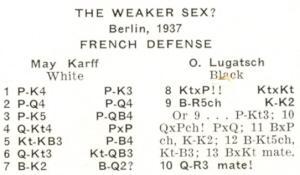
Other writers have gone their own way. Page 107 of Chess More Miniature Games by J. du Mont (London, 1953) dated the gamelet 1897, whereas on page 26 of 500 French Miniatures (Collection II) by Bill Wall (Moon Township, 1995) Black’s name was given as Lugatsca and the occasion as New York, 1938. Page 110 of The Quickest Chess Victories of All Time by Graham Burgess (London, 1998) stated that White was Karth.
When the score appeared opposite page 9 of Estrategia, 1 March 1942 (Black being ‘N.N.’) it was accompanied by this photograph of Mona May Karff:
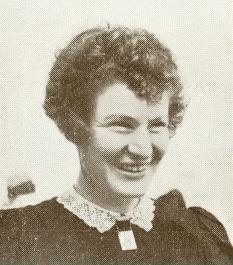
C.N. 5080 asked whether the clock dispute in the game Capablanca v Emanuel Lasker at New York, 1924 was public knowledge before Lasker wrote about it in De Telegraaf of 3 January 1927. Luca D’Ambrosio (Bolzano, Italy) cites the following from page 74 of Deutsches Wochenschach, 30 April 1924:
‘Auffällig ist eine Mitteilung, die Dr. A. Seitz, der als Zuschauer dem Turnier beigewohnt hat, über die Partie Capablanca-Dr. Lasker macht. Danach wäre die Niederlage L’s die Folge eines Uhrendefekts. L sei infolge dieses Defekts, der zur Folge hatte, daß im kritischen Augenblick beide Uhren gingen, in Zeitnot geraten u. habe das Remis übersehen.’ [Our English translation: ‘A noteworthy report comes from Dr A. Seitz, who attended the tournament as a spectator, regarding the Capablanca-Dr Lasker game. It states that L.’s defeat was the result of a defective clock; owing to that fault, which caused both clocks to be running at the critical moment, Lasker fell into Zeitnot and overlooked the draw.’]
More generally, our correspondent refers to a sentence written by Seitz on page 146 of the May 1924 Wiener Schachzeitung:
‘Dem Turniersekretär konnte man nicht das Lob allzu großer Unparteilichkeit geben.’ [‘The tournament secretary could not be praised for excessive impartiality.’]
Finally, Mr D’Ambrosio quotes a passage from the report about New York, 1924 on page 3 of volume one of Schachjahrbuch 1924 by L. Bachmann (Ansbach, 1925):
‘Über ihre Aufnahme und ihren Aufenthalt haben sich die Turnierteilnehmer sehr günstig ausgedrückt. Selbstverständlich gab es die regelmässigen Klagen über gewisse Rücksichtslosigkeiten einzelner Meister, wie gewöhnlich so auch hier, auch fehlten nicht Beschwerden wegen Parteilichkeit des Turnierleiters von deutscher Seite.’ [‘The participants in the tournament expressed great satisfaction with their welcome and stay. Of course, there were the regular grievances about certain inconsiderate behaviour by individual masters, as is usual and as occurred here too, and there was no lack of complaints of favouritism by the tournament director, from the German side.’]
Following criticism of him in Lasker’s book Mein Wettkampf mit Capablanca (Berlin and Leipzig, 1922), a reply by Capablanca was given on pages 376-380 of the October 1922 BCM. As mentioned on page 195 of our volume on the Cuban, Lasker subsequently stated (see, for instance, page 37 of the February 1927 American Chess Bulletin) that he had submitted a response to the BCM but that it was returned to him unpublished.
Is that text of Lasker’s available anywhere?
‘Counter-attack is the best form of defence’ is a familiar chess dictum, but when was it first formulated?
The best citation we can currently offer is ‘La contre-attaque est une excellente manière de se défendre’ on page 51 of Nouveau manuel illustré du jeu des échecs by J.A. de Rivière (Paris, 1892). That was not the first edition of the book, so it may well be possible to trace the idea further back.

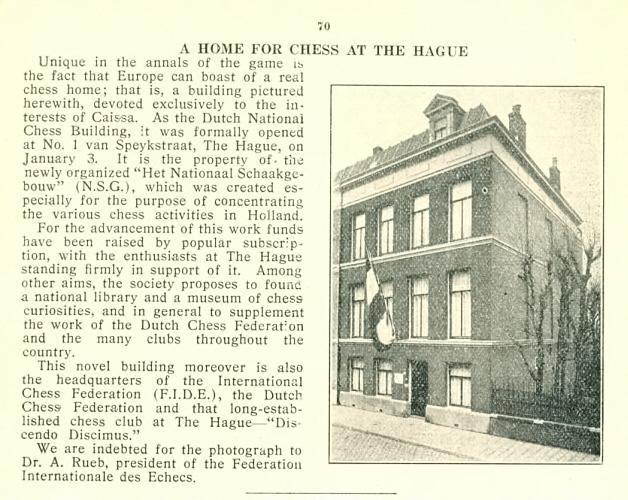
American Chess Bulletin, March 1927, page 70
Harrie Grondijs (Rijswijk, the Netherlands) has sent us the photograph below, taken on 31 July 2007:
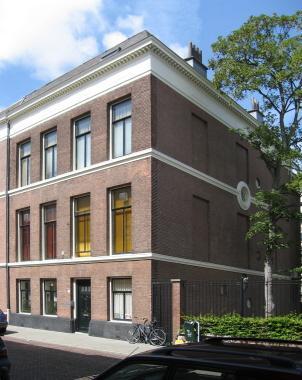
Mark McCullagh (Belfast, Northern Ireland) notes from our Earliest Occurrences of Chess Terms article that the Oxford English Dictionary cites for ‘en passant’ a passage in Practical Chess Exercises by W.S. Kenny (London, 1818). Our correspondent quotes from page 5 (with three other instances elsewhere) of volume one of A Treatise on the Game of Chess by J.H. Sarratt (London, 1808):
‘15. A Pawn that is pushed two steps may be taken “en passant”, by the adversary’s Pawn.
N.B. This is not the case in Italy; a Pawn is allowed to pass “en prise”; and that is called “passar battaglia”.’
Anyone can sling together lists of sourceless quotes about chess, and many lackadaisical webpages do so. However, Mark N. Taylor (Mt Barry, GA, USA) points out a rare exception, PoemHunter.com, and observes:
‘The selection is small and almost entirely drawn from non-chess publications. Nonetheless, it is gratifying to see that a webmaster can do it right.’
From Fischer’s guest appearance in autumn 1972 on The Bob Hope Special television show, which also starred Mark Spitz, we have made three stills:
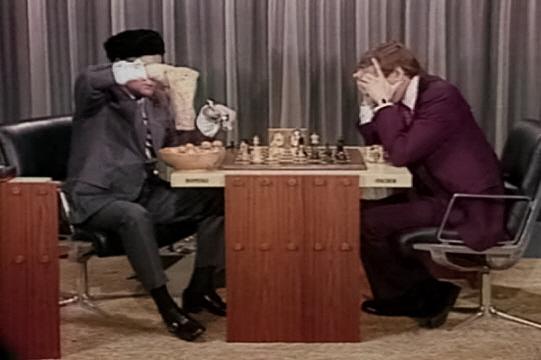
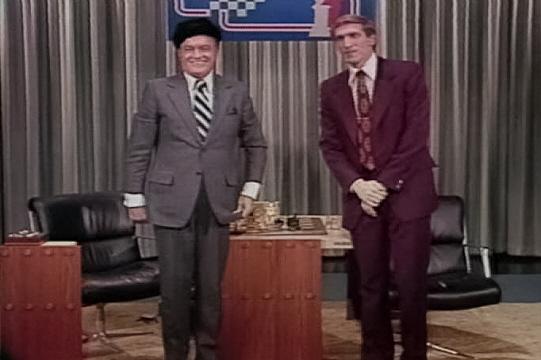
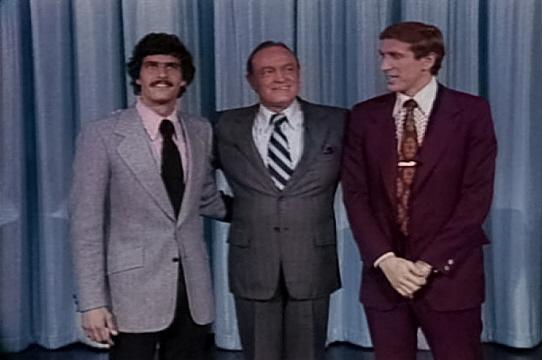
In the early part of the programme Bob Hope (‘Hopeski’) was shown enduring a lonely wait at the board. The world champion’s eventual arrival led into some rather wooden banter (naturally covering such topics as unpunctuality, cameras, noise and money), whereafter the comedian played 1 c4 and won a top-speed game during which he muddled chess and checkers and elicited the loudest possible racket from a bag of nuts.
Although the cue-cards were successfully kept off-camera, the production and editing were choppy, with, even, Hopeski’s king and queen switching places between two shots at the start of the game. The sketch lasted six minutes. Fischer received a very warm reception, although not the standing ovation accorded to Mark Spitz.
The first entry in our feature article Early Uses of ‘World Chess Champion’ is a citation for ‘Champion of the World’, with reference to Staunton, dating from 1845. Jon Crumiller (Princeton, NJ, USA) now draws attention to a passage (conveying the same concept, but without the word ‘champion’) on page 116 of The History of Chess by Richard Lambe (London, 1764):
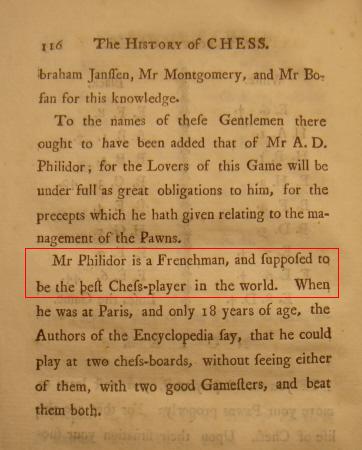
[Afterword: We have been reminded that this passage in R. Lambe’s book already appeared in C.N. 4369, courtesy of Robert John McCrary (Columbia, SC, USA).]
Mr Crumiller also refers to our feature article The Knight Challenge, which quotes chess writers’ efforts from the nineteenth century onwards to describe the knight’s move. He adds earlier examples:
Our correspondent mentions too that the description quoted in our article from Stratagems of Chess (1817) is a word-for-word copy from page 117 of Hoyle’s Games Improved (1800) and that a very similar text occurs on page 88 of R. Lambe’s The History of Chess (1764):
‘The Knights move obliquely, stepping upon every third square, including that which they quit; from black to white, and from white to black, over the heads of men, which none else do.’
C.N.s 3753 and 3800 discussed a claim that Armand Edward Blackmar composed music which was included in the film Gone with the Wind. Now Djordje Petrović (Belgrade) draws attention to an article ‘Songs of the Civil War’ by Charles Hamm. Without providing the details sought, it offers interesting background information, mentioning Gone with the Wind and Blackmar.
Luca D’Ambrosio (Bolzano, Italy) submits a further report on the dispute regarding the game Capablanca v Emanuel Lasker, New York, 1924 (from Deutsches Wochenschach, 15 June 1924, page 110):
Our translation:
‘The apparent clock defect in the Capablanca-Lasker game. Dr A. Seitz stated in his tournament reports, among personal attacks on the New York tournament director, N.L. Lederer, that Lasker’s defeat against Capablanca was due to a clock defect, as a result of which at the critical moment both clocks were running and L., who was in Zeitnot, overlooked the draw. Ignoring the personal attacks, we briefly mentioned this information on page 74 on the assumption that an explanation would not be lacking. In a communication Mr Lederer has now drawn to our attention the fact that Dr Seitz did not have access to the playing tables and therefore knew of the matter only by hearsay. “I noticed”, observes Mr Lederer in this respect, “that during the game Dr L. did not press the ‘off’ lever on his clock far enough and that both clocks were running. When play was broken off at six o’clock, we noted precisely the time difference, which was around eight minutes. It should be remarked here that Dr L. was not in Zeitnot at any time. On the contrary, before the end of play C. was in considerable Zeitnot and twice after the piece sacrifice did not make the best moves (Qf3 instead of Qe2 and Nxd6 instead of g4 [sic]). When play resumed at eight o’clock both players were, of course, out of Zeitnot, and the move which, according to Dr L.’s analysis, offered Black the prospect of a draw (Bd5 instead of Qe6) took place long after play had been interrupted ... Dr L. has, of course, never made a remark which could be interpreted as meaning that he lost the game for any reasons other than those having to do with chess, and he spoke about his opponent’s play with the greatest respect; he merely remarked that Qe6 was the losing move and that Bd5 would probably have given him a draw, and analysis will surely bring a final verdict on this.” Mr Lederer goes on to express his regret over the derisive and denigrating comments made by Dr Seitz about the committee and the tournament management, which are as unjustified as they are untrue. He says that this could cause the men whom we have to thank for the organization of the tournament not to repeat their efforts, undertaken purely in the interests of chess, if the result of their work is mean-spirited attacks by people who have enjoyed the hospitality of the Manhattan Chess Club and the Hotel Alamac. In the end, Dr Seitz was requested no longer to enter the premises of the Manhattan Chess Club.’
When the Lasker affair blew up in the United States in January 1927, Lederer wrote as follows regarding the clock incident on page 71 of the March 1927 American Chess Bulletin:
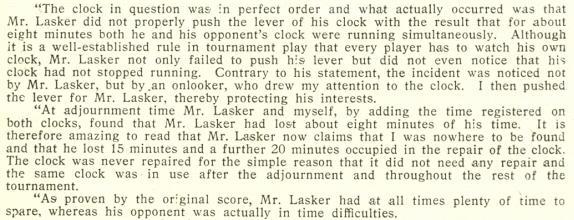
The rules for New York, 1924 were given on pages 27-28 of the
February 1924 American Chess Bulletin. The time-limit was 30
moves
in the first two hours and 15 moves an hour thereafter. The playing
hours stipulated there (13.30-17.30 and 19.30-23.30) were subsequently
amended to 14.00-18.00 and 20.00-00.00 (American Chess Bulletin,
March
1924, page 49). For
Capablanca’s
score-sheet of his victory over Lasker see page 80 of A Picture
History
of Chess by Fred Wilson (New York, 1981).
Jan Kalendovský (Brno, Czech Republic) submits a photograph of Karel Treybal’s gravestone in Prague:
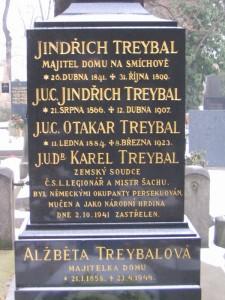
The exact location is Prague 5 – U Smíchovského hřbitova 1, Malvazinky. For information about Treybal’s death (by execution on 2 October 1941) see C.N.s 3729 and 3733.
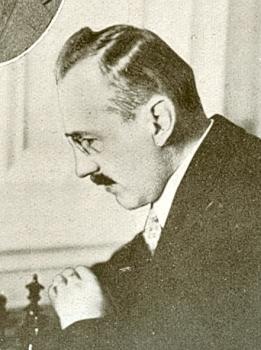
Karel Treybal
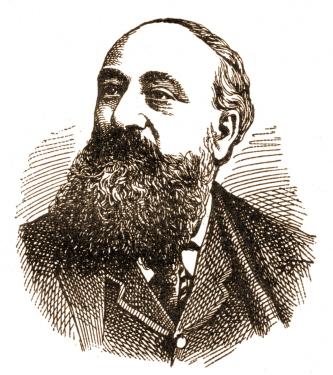
G.H.D. Gossip
Tim Harding (Dublin) comments that a specimen of Gossip’s signature given in the May 2001 BCM, page 265, ‘does seem to support the Hatfeild spelling’. He adds, further to the Gossip entry in Jeremy Gaige’s Chess Personalia (Jefferson, 1987), that the reference for the death certificate mentioned by Gaige is Petersfield 2c 84. Does any reader have a copy of the certificate?
As indicated in C.N. 5075, the ‘Hatfeild’ spelling became common usage after its appearance in The Oxford Companion to Chess in 1984. Earlier, the Companion’s co-authors had used ‘Hatfield’ on page 306 of the October 1964 BCM (D. Hooper) and on page 408 of the September 1979 BCM (K. Whyld). As noted in our feature article Gossip, it was Hooper who revealed, in 1964, where and when Gossip died (in Liphook, Hampshire, England on 11 May 1907).
C.N. 3384 quoted from page 33 of Morphy Gleanings by P.W. Sergeant (London, 1932):
‘I see no reason for the suggestion of some writers, including G.C. Reichhelm, that it was a case of suicide – by opening a vein, Reichhelm says.’
We are still seeking information on where Reichhelm, or any other writers, claimed that Morphy killed himself.
As noted on page 109 of our book on Capablanca, in June 1920 Lasker abdicated as world champion. A prime source for this information is page 126 of the July-August 1920 American Chess Bulletin, part of which is reproduced below:
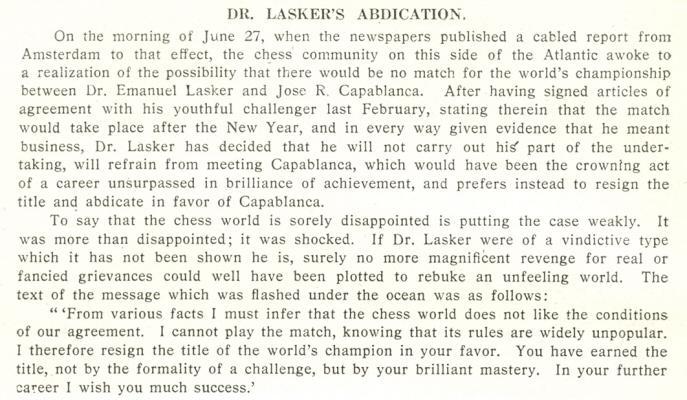
Javier Asturiano Molina (Murcia, Spain) notes that a slightly different wording appeared in Lasker’s letter of 18 June 1920 to Capablanca, written from the Hotel Stadt Elberfeld, Amsterdam. It was reproduced on page 214 of The Collected Games of Emanuel Lasker by K. Whyld (Nottingham, 1998).
David DeLucia (Darien, CT, USA) informs us that he owns a letter dated 17 June 1920 written by Lasker to his wife, from Huize Parkzicht in Amsterdam, in which he stated that he had resigned the world title that day. The document will be appearing in a book on Mr DeLucia’s collection which he is currently preparing.
Mr DeLucia also mentions that he owns one of the paintings of Lasker featured in C.N. 5071. This is another matter on which full particulars will be presented in his forthcoming book, but he has kindly authorized us to reproduce the illustration below:
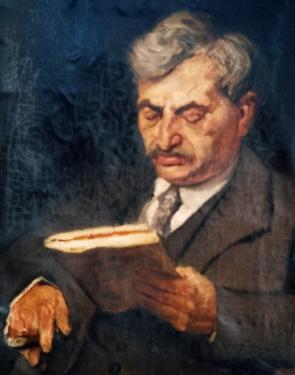
Copyright 2007 Edward Winter. All rights reserved.